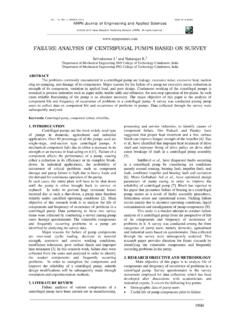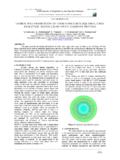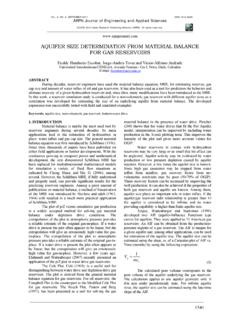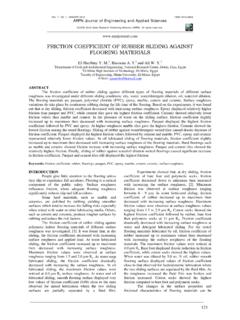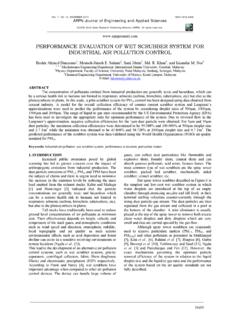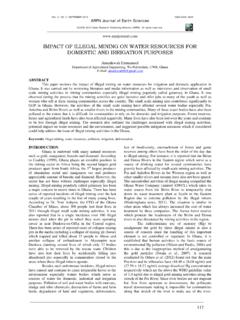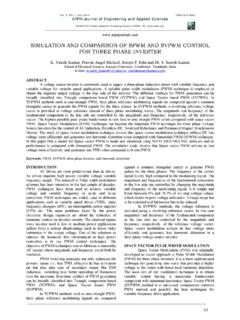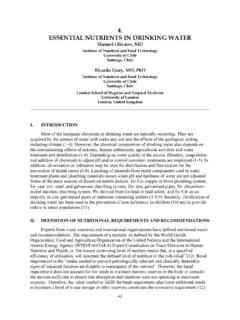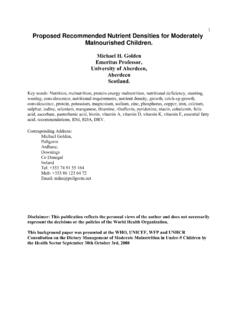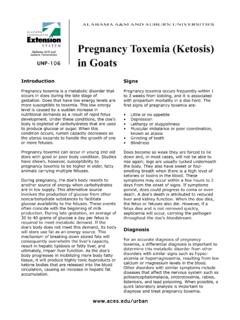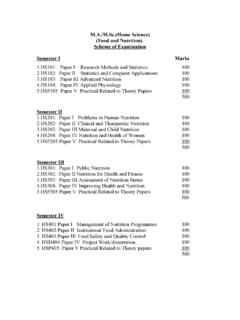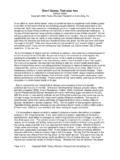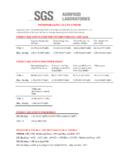Transcription of NUTRITIONAL STATUS ASSESSMENT OF HEMODIALYSIS …
1 VOL. 8, NO. 4, APRIL 2013 ISSN 1990-6145. ARPN Journal of Agricultural and Biological Science 2006-2013 Asian Research Publishing Network (ARPN). All rights reserved. NUTRITIONAL STATUS ASSESSMENT OF HEMODIALYSIS PATIENTS. AT REHMAN MEDICAL INSTITUTE PESHAWAR. Bibi Hajira, Muhammad Samiullah and Rattan Kaur Chawla Department of Human Nutrition, Faculty of NUTRITIONAL Sciences, Khyber Pakhtunkhwa Agricultural University, Peshawar, Pakistan E-mail: ABSTRACT. A study was conducted to assess the NUTRITIONAL STATUS of HEMODIALYSIS patients visiting Rehman Medical Institute, Peshawar. A total of 66 subjects from both sexes having mean age years undergoing HEMODIALYSIS were enrolled for the study. Information regarding disease history and associated comorbidities were collected from patient's files.
2 NUTRITIONAL STATUS was assessed by anthropometric measurements using body mass index (BMI). The biochemical results including kidney profile, serum electrolytes and hemoglobin were recorded from the patient's files. Dietary data was obtained by using 24-hour dietary recall and food frequency questionnaire. The results indicated that age, familial predisposition, hypertension, diabetes and heart disease increased the risk for renal failure. Renal failure was more prevalent among male than in female. Actual intake of calories, protein, fats and minerals was lower than the recommended intake for HEMODIALYSIS patients. More than 50 percent of patient on HEMODIALYSIS were at risk of malnutrition. Malnutrition was related to low nutrient intake.
3 This study suggests that ASSESSMENT of NUTRITIONAL STATUS and NUTRITIONAL management of HEMODIALYSIS patients play a central role in preventing malnutrition. Keywords: HEMODIALYSIS , NUTRITIONAL STATUS , hypertension, diabetes, malnutrition. INTRODUCTION Pakistan showed an increase in number of patients from Chronic kidney disease is a progressive loss of 4393 to 6127 during 2007 to 2008 (PKF, 2008). kidney functions, defined as kidney damage or an HEMODIALYSIS is the long term form of estimated glomerular flirtation rate of less than 60 mechanical renal replacement therapy, used to remove ml/ (Levey et al., 2005). It is a major public waste products from the blood of patients with end-stage health problem which affects over 500 million people renal disease (Ahmad et al.)
4 , 2002; Crowley, 2009). worldwide (Davids, 2007). The national health and HEMODIALYSIS substitutes for functions of the kidney, by nutrition examination survey has estimated the prevalence cleaning and filtering blood to temporarily rid body of of chronic kidney disease in the United States as 26 harmful wastes, extra salt and extra water. It helps control million (Synder et al., 2009). Among risk factors diabetes blood pressure and keeps the proper balance of important is the leading cause, accounting for about 30% to 40% of electrolytes in the body (NKUDIC, 2010). In patient with the disease (Connell et al., 2009). Other factors including chronic renal failure who are not undergoing dialysis, if hypertension, smoking, hypercholesterolemia, obesity, protein-energy malnutrition develops or persists despite age, gender and family history also potentially contribute vigorous attempts to optimize protein and energy intake to the development of chronic kidney disease (Levin, and there is no apparent cause for malnutrition other than 2001; White et al.
5 , 2005). low nutrient intake, initiation of HEMODIALYSIS or renal Untreated chronic kidney disease leads to a final transplant is recommended (NKF, 2002). stage called end-stage renal disease and is defined by a Protein-energy wasting is a common glomerular flirtation rate of less than 15 ml/ complication and an important predictive factor for When a patient reaches end-stage renal disease, renal mortality in chronic HEMODIALYSIS patients (Segall et al., replacement therapy in the form of dialysis or 2008). The causes of protein-energy wasting include transplantation remains the sole treatment (NKF, 2010). protein metabolism impairment, amino acid and nutrient Whereas acute renal failure is characterized by sudden loss losses in dialysate, dialysis-induced muscle catabolism, of the ability of the kidneys and also sometimes metabolic acidosis, increased energy expenditure, necessitate dialysis (Robert et al.
6 , 2004). The estimated resistance to anabolic hormones, anorexia and global dialysis population for end-stage renal disease is underdialysis (Chazot, 2004). Reduced renal function is over million, increasing at a rate of 7% per year and associated with a high prevalence of cardiovascular will be 2 million by the year 2010 (Lystaght, 2002). The disease risk factors, such as hypertension, diabetes, third national health and nutrition examination survey dyslipidemia, and left ventricular hypertrophy (Minami et estimated million end-stage renal disease cases in the al., 2008). Anemia occurs because the diseased kidney United States (Coresh et al., 2003). The number of loses its ability to produce erythropoietin that is essential patients with end-stage renal disease in Pakistan is for the production of hemoglobin (Robinson, 2006).
7 Renal continuously increasing with an estimated annual osteodystrophy is a complex disorder of bone associated incidence of 100 per million populations (Sanai et al., with end-stage renal failure due to disturbances in mineral 2010). The dialysis registry data from 172 centers in metabolism including phosphate retention, hypocalcaemia, vitamin-D deficiency, and hyperparathyroidism (Sprague, 329. VOL. 8, NO. 4, APRIL 2013 ISSN 1990-6145. ARPN Journal of Agricultural and Biological Science 2006-2013 Asian Research Publishing Network (ARPN). All rights reserved. 2010). Hyperparathyroidism and hyperphosphatemia in NUTRITIONAL STATUS was assessed by Body Mass turn associated with increased coronary artery calcification Index method (WHO, 1995).
8 Respondents having BMI. (Chertow, 2003). < were considered as under-weight, having BMI. Poor NUTRITIONAL STATUS is one of the main risk > as normal weight, having BMI as factors for mortality in HEMODIALYSIS patients and therefore over-weight, having BMI > 30 as obese and having BMI >. needs to be regularly assessed and treated. Close 40 as morbid obese. NUTRITIONAL STATUS was also assessed collaboration between dialysis and dietetic staffs remains by National Kidney Foundation (NKF) criteria that is essential to handle this challenge. Evaluation of the BMI<23 and BMI>23 because mortality and morbidity NUTRITIONAL STATUS relies on biological parameters and rate is high in HEMODIALYSIS patients having BMI<23.
9 Anthropometrics, with food intake records. The recommended intakes are g/ kg/day for proteins, and Clinical ASSESSMENT 35 Kcal/kg/day for energy in HEMODIALYSIS patients For clinical ASSESSMENT , each patient was (Chazot, 2004). interviewed for the uremic symptoms (anorexia, nausea, Since end-stage renal disease is becoming a vomiting, headache and others) and examined for the signs major cause of disability and mortality and the information of fluid over loaded (edema, chest crackle, raised jugular available about the NUTRITIONAL STATUS of HEMODIALYSIS vein pressure) and responses were recorded on the patients in developing countries including Pakistan is very questionnaire. The recorded responses were then little.
10 The purpose of this study was therefore to assess the converted into percentages. NUTRITIONAL STATUS of HEMODIALYSIS patients visiting Rehman Medical Institute, Hayatabad, Peshawar, Pakistan. Biochemical ASSESSMENT About 4 ml blood samples were taken from each MATERIALS AND METHODS patient for the determination of kidney profile (blood urea, serum creatinin and glomerular filtration rate) serum Location of the study electrolytes (sodium, potassium, chloride, bicarbonate). The hospital based study was carried out at the and 3 ml for Complete blood count (hemoglobin and HEMODIALYSIS unit of Rehman Medical Institute, Peshawar, WBC). with the purpose to observe and undertake the protocol followed in the hospital to assess the NUTRITIONAL STATUS of Dietary ASSESSMENT the patients visiting for HEMODIALYSIS and different wards For dietary ASSESSMENT , each patient was for the treatment of chief complaints and associated co- interviewed for the consumption of food and beverages morbidities.
